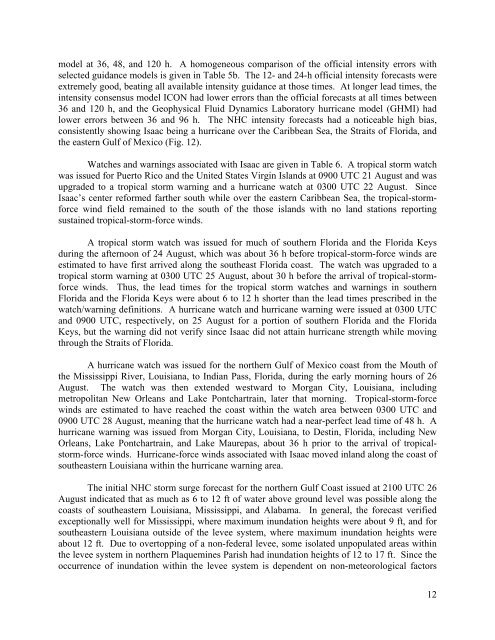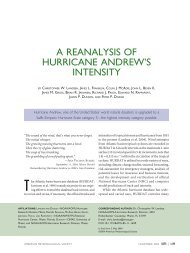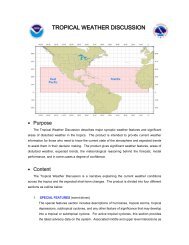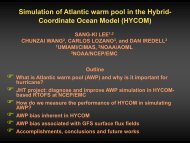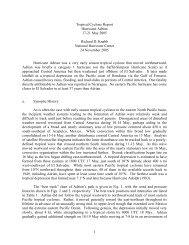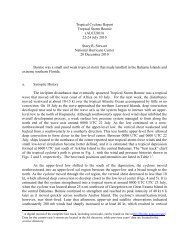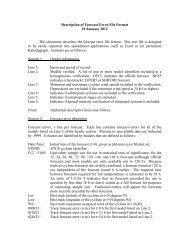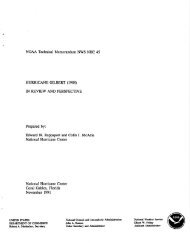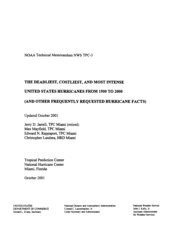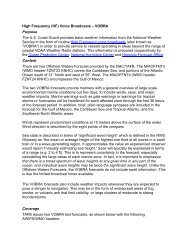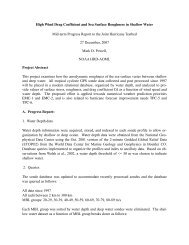Tropical Cyclone Report - National Hurricane Center - NOAA
Tropical Cyclone Report - National Hurricane Center - NOAA
Tropical Cyclone Report - National Hurricane Center - NOAA
Create successful ePaper yourself
Turn your PDF publications into a flip-book with our unique Google optimized e-Paper software.
model at 36, 48, and 120 h. A homogeneous comparison of the official intensity errors with<br />
selected guidance models is given in Table 5b. The 12- and 24-h official intensity forecasts were<br />
extremely good, beating all available intensity guidance at those times. At longer lead times, the<br />
intensity consensus model ICON had lower errors than the official forecasts at all times between<br />
36 and 120 h, and the Geophysical Fluid Dynamics Laboratory hurricane model (GHMI) had<br />
lower errors between 36 and 96 h. The NHC intensity forecasts had a noticeable high bias,<br />
consistently showing Isaac being a hurricane over the Caribbean Sea, the Straits of Florida, and<br />
the eastern Gulf of Mexico (Fig. 12).<br />
Watches and warnings associated with Isaac are given in Table 6. A tropical storm watch<br />
was issued for Puerto Rico and the United States Virgin Islands at 0900 UTC 21 August and was<br />
upgraded to a tropical storm warning and a hurricane watch at 0300 UTC 22 August. Since<br />
Isaac’s center reformed farther south while over the eastern Caribbean Sea, the tropical-stormforce<br />
wind field remained to the south of the those islands with no land stations reporting<br />
sustained tropical-storm-force winds.<br />
A tropical storm watch was issued for much of southern Florida and the Florida Keys<br />
during the afternoon of 24 August, which was about 36 h before tropical-storm-force winds are<br />
estimated to have first arrived along the southeast Florida coast. The watch was upgraded to a<br />
tropical storm warning at 0300 UTC 25 August, about 30 h before the arrival of tropical-stormforce<br />
winds. Thus, the lead times for the tropical storm watches and warnings in southern<br />
Florida and the Florida Keys were about 6 to 12 h shorter than the lead times prescribed in the<br />
watch/warning definitions. A hurricane watch and hurricane warning were issued at 0300 UTC<br />
and 0900 UTC, respectively, on 25 August for a portion of southern Florida and the Florida<br />
Keys, but the warning did not verify since Isaac did not attain hurricane strength while moving<br />
through the Straits of Florida.<br />
A hurricane watch was issued for the northern Gulf of Mexico coast from the Mouth of<br />
the Mississippi River, Louisiana, to Indian Pass, Florida, during the early morning hours of 26<br />
August. The watch was then extended westward to Morgan City, Louisiana, including<br />
metropolitan New Orleans and Lake Pontchartrain, later that morning. <strong>Tropical</strong>-storm-force<br />
winds are estimated to have reached the coast within the watch area between 0300 UTC and<br />
0900 UTC 28 August, meaning that the hurricane watch had a near-perfect lead time of 48 h. A<br />
hurricane warning was issued from Morgan City, Louisiana, to Destin, Florida, including New<br />
Orleans, Lake Pontchartrain, and Lake Maurepas, about 36 h prior to the arrival of tropicalstorm-force<br />
winds. <strong>Hurricane</strong>-force winds associated with Isaac moved inland along the coast of<br />
southeastern Louisiana within the hurricane warning area.<br />
The initial NHC storm surge forecast for the northern Gulf Coast issued at 2100 UTC 26<br />
August indicated that as much as 6 to 12 ft of water above ground level was possible along the<br />
coasts of southeastern Louisiana, Mississippi, and Alabama. In general, the forecast verified<br />
exceptionally well for Mississippi, where maximum inundation heights were about 9 ft, and for<br />
southeastern Louisiana outside of the levee system, where maximum inundation heights were<br />
about 12 ft. Due to overtopping of a non-federal levee, some isolated unpopulated areas within<br />
the levee system in northern Plaquemines Parish had inundation heights of 12 to 17 ft. Since the<br />
occurrence of inundation within the levee system is dependent on non-meteorological factors<br />
12


